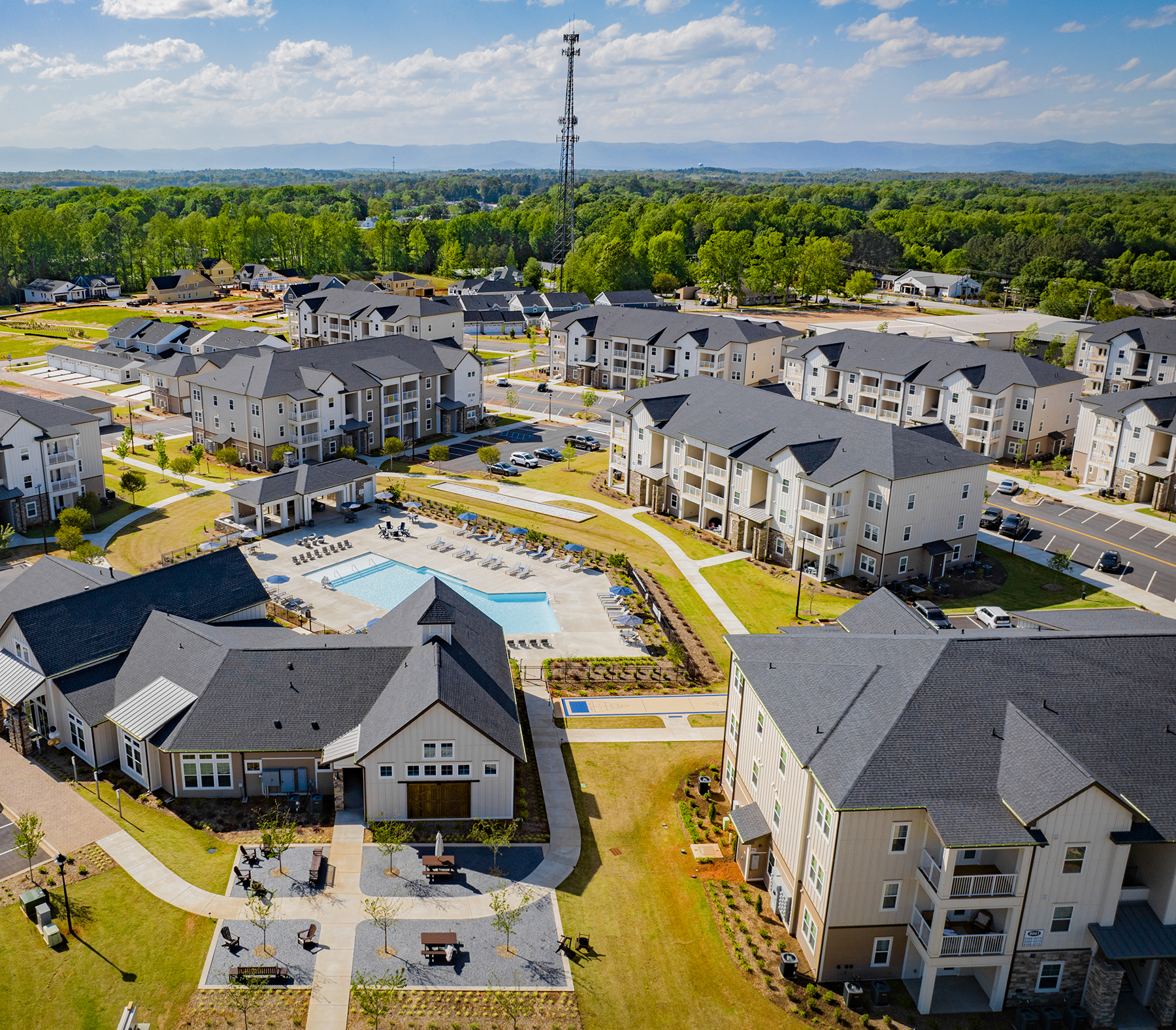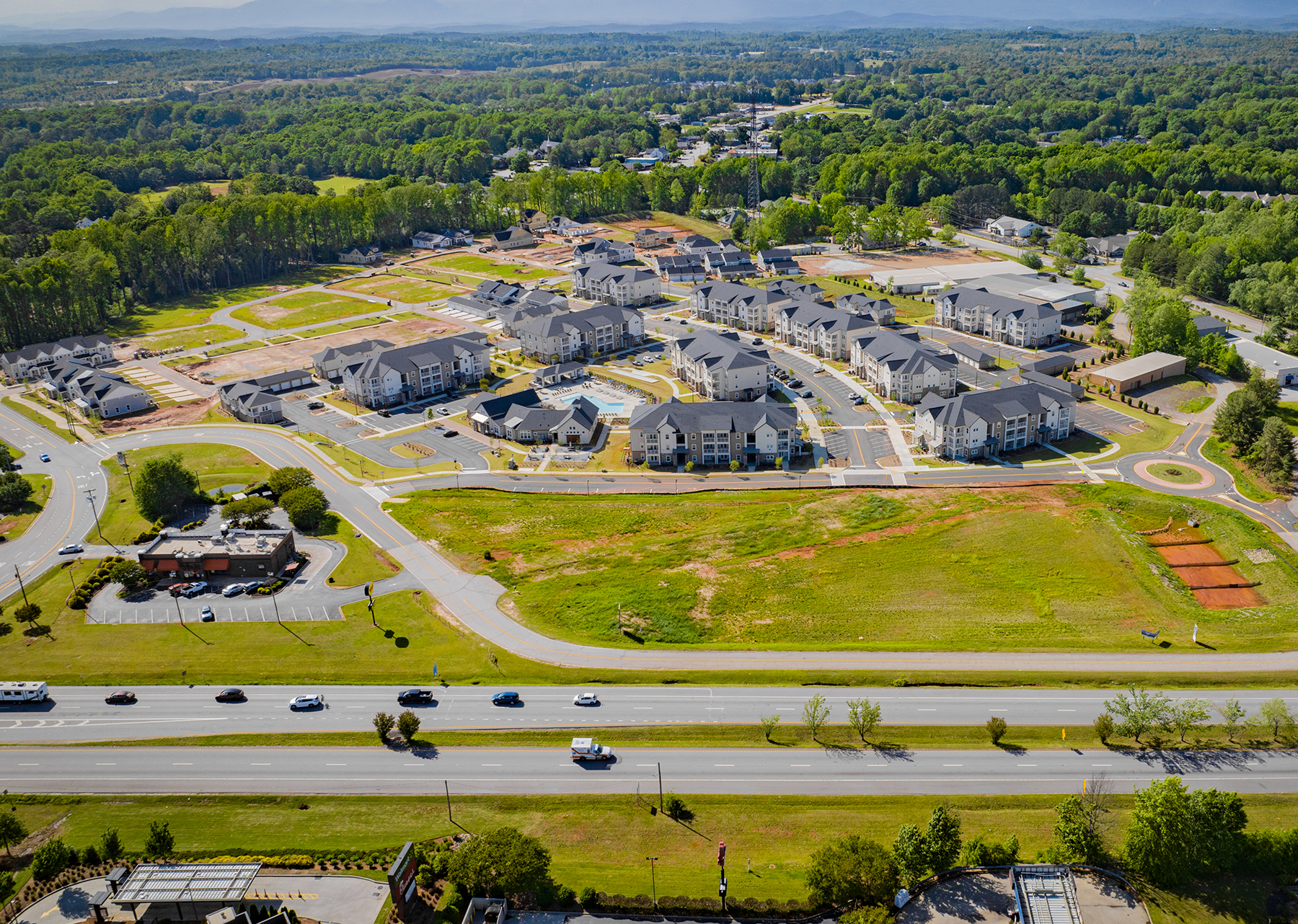By Robert L. Reid
A new mixed-use, multimodal development in Travelers Rest, South Carolina — just north of Greenville — was designed to connect residents to trails, parks, and other outdoor amenities without making them rely on automobiles or other motorized transit options. The Pinestone development, now under construction, will feature 100 single-family homes, 250 apartments, and 77,000 sq ft of commercial space within a roughly 45-acre property on the southeastern edge of Travelers Rest. The development is nestled within a triangular-in-plan setting bordered by U.S. Highway 25 on the east and Main Street/U.S. Highway 276 on the west.
Constructed on what had been a warehouse district, Pinestone was designed to better connect residents of the new development and existing neighborhoods in Travelers Rest to parks, trails, and green spaces in the area, says Paul Talbert, P.E., a civil engineering team lead at SeamonWhiteside, the Greenville-based firm that was responsible for the project’s civil engineering design, landscape architecture, planning, and other functions. The developers are TRG Communities, of Greenville, and Spartanburg, South Carolina-based Longbranch Development. The architects are Charlan Brock Architects, of Maitland, Florida, and Greenville-based McMillan Pazdan Smith Architecture. The general contractors are Creative Builders Inc., of Greenville, and Pinestone Builders, of Greer, South Carolina.

Getting greener
One key goal of the Pinestone design is to connect people with the region’s popular Swamp Rabbit Trail, a 22 mi long pedestrian and bicycle greenway along the Reedy River between Travelers Rest and Greenville, notes Talbert. A rails-to-trails project, the Swamp Rabbit Trail largely follows the route of the defunct Greenville & Northern Railway.
To improve access to the Swamp Rabbit Trail, the Pinestone project is bisected by a greenway of its own making — a 2,150 ft long, 10 ft wide trail, mostly paved and surrounded by extensive landscaping that features native plants so that the new greenery “looks like it’s been there forever,” Talbert says. This path through Pinestone provides a direct link between the downtown area of Travelers Rest to the north and the Swamp Rabbit Trail to the south, passing between various residential sections of the new development, crossing a small creek via a new bridge, and meandering by an enhanced bioretention swale for stormwater management, Talbert explains.
A second new greenway, 1,600 ft long, essentially follows the southern boundary of the Pinestone site along Roe Road. Although this greenway does not connect directly to the Swamp Rabbit Trail, it does link to another path that leads to the trail.
The goal is for Pinestone residents to get home from work and be able to travel to local restaurants, shops, and other amenities by foot or bicycle, Talbert says, without having to get back into their cars and drive long distances to get places.
The main greenway that bisects the project is complete, as are the multifamily apartment buildings, Talbert says. The southern greenway should be completed later this year. The single-family homes are under construction, and the commercial spaces are in design. The full development should be completed within 3-4 years, Talbert estimates.
Underground efforts
In addition to deconstructing the warehouses and their foundations that had been on the Pinestone site, the project also worked with the local utilities to remove or incorporate existing underground pipes and other obstacles. These included a pair of large water mains — 30 in. and 36 in. in diameter, respectively — that ran from a reservoir to the north of Pinestone, under the planned commercial district, down to the Greenville area, Talbert noted. The utility did not want to relocate those mains, he adds, so the project had to design around them, making sure that no buildings would encroach on the easement, although it was permitted to have driveways and parking areas cross over the pipes, Talbert adds.
“Quite a bit of dirt” was moved around on-site, Talbert adds, and in one depressional area, some undocumented fill was discovered. Consequently, the contractors had to overexcavate the depressional area, fill it with a crushed rock mix, and haul away the excavated material. “It was quite a process and left several large mounds of soil on-site, including one just of the topsoil that was stripped and then redistributed over the site for planting areas,” Talbert explains.

Working together
Along with the new greenways, other planned amenities within Pinestone include the commercial area’s shops and restaurants, a dog park, an amphitheater, and various public parks. The development includes various features unique to the region that required the Pinestone team — especially Caroline Donaldson, a SeamonWhiteside land planner — to work closely with Travelers Rest officials on the city’s municipal codes and land development regulations, Talbert says. For instance, the sidewalks in Travelers Rest tend to be 4 ft wide, whereas Pinestone sidewalks generally measure 8 ft wide — up to 12 ft in some locations — to provide sufficient space for pedestrians, joggers, bicyclists, and people on scooters to move along the path at the same time, Talbert explains.
The Pinestone team also worked with local leaders to permit new alley typologies that allow for rear-facing garages, so that the fronts of the houses can face onto green spaces instead of busy roads, says Talbert. The change “creates a new urban feel that encourages pedestrian activity, encourages community,” he says. “People can walk out on their front porch and see neighbors walking past on a greenway and other pedestrian pathways, which encourages this idea that you belong somewhere, a place where people are integrated into the community.”
This article is published by Civil Engineering Online.



